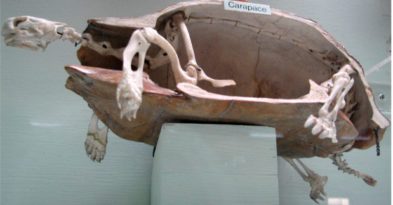 A “normal” turtle skeleton. A “normal” turtle skeleton. Genesis 2:19 “And out of the ground the LORD God formed every beast of the field, and every fowl of the air; and brought them unto Adam to see what he would call them: and whatsoever Adam called every living creature, that was the name thereof.” A new fossil is causing a lot of interest among cheniologists – those who study turtles, tortoises and terrapins. These animals are well known for possessing a protective shell. There are two shells. Under the animal is the plastron, while the upper shell is the carapace. Plastron and carapace, which are cartilaginous, are joined by bony bridges. As these bridges are associated with the ribs, evolutionists believe that the turtle’s shell evolved from the animal’s ribs. Recently, a fossil, called eorhynchochelys (“Ay-oh-rink-oh-keel-is”) has been discovered, which seems to be a turtle, but also seems to have no shell. One of the fossil’s discoverers – a researcher at the National Museums of Scotland – said, “It shows that early turtle evolution was not a straightforward, step-by-step accumulation of unique traits but was a much more complex series of events that we are only just beginning to unravel.” So is this shell-less turtle an evolutionary ancestor? Fossilization is a process which is both slow and rare. The right conditions for death and burial must be available. Frequently, fossils can be found which differ from parent species only by some illness or growth. Therefore, eorhynchochelys could simply be a mutant, born without a shell, or a turtle with a soft shell, or one that has lost its shell in an injury, as a small number of turtle survivors of catastrophes has shown. In any event, eorhynchochelys is not in any way evidence for evolution. It is simply an interesting fossil, and its traits can easily be explained within a biblical context. creationmoments.com/sermons/mutant-turtles Comments are closed.
|
Archives
February 2020
|
Ads do not imply endorsement | Policy/Terms of Service | About Us | Contact Us | © Life Work Academy, Inc.
 RSS Feed
RSS Feed

